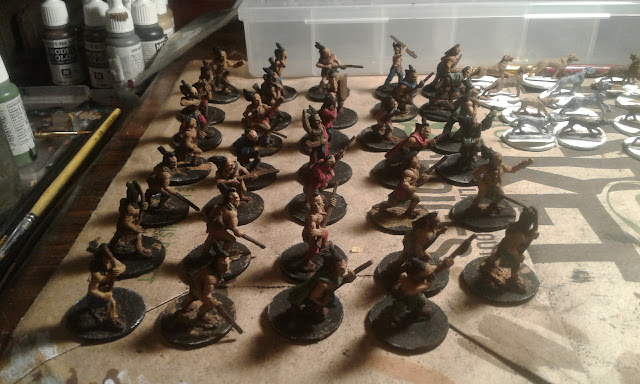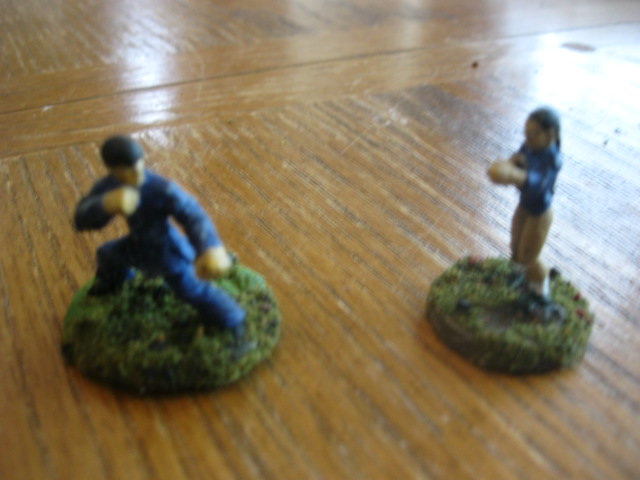PREFACE --I'm a writer, That means I write stuff. Please check out my newest release, a short story collection called "Put Your Favorite Picture Here" at
https://www.amazon.com -However, that's not my only work. This post is an excerpt from my current project, a guide for wargamers to Roman Gladiators. Taking a tip from Cory Dotorow, I've decided to share this work in progress chapter by chapter on my blog.
If you wish to support this blog, well, at the moment there's no Patreon button, but feel free to show your enthusiasm and support by browsing the blog, checking out the other posts, sending links to friends and sharing through social media, and leaving comments and asking questions or starting discussions. Thanks.
Ancient Rome-What was the arena and what were “the games”?

The “Roman Games”
consisted of several kinds of events. In this section, we will look at the
events and discuss what they were as well as look at their potential for
gaming.
1.
Gladiatorial Combats
Of course, one of
the most common and popular events at the Roman Games were Gladiatorial
Combats. These consisted of staged fights between individuals or small (perhaps
less than ten at the most to give an estimate) groups of fighters. These fights
were staged and scheduled. The fighters, although usually not volunteers, could
be considered professionals in that they were trained, drilled, and kept in
shape for the purpose of appearing in events such as these.
The fighters were
classified into different types. Each type was equipped in a certain way to
fight and trained to fight in a certain style that fit their armor and weaponry
as well as the mythology and background behind the type of fighter they were
supposed to be portraying. These different types will be discussed in a later
chapter. Suffice it to say that there were customs and traditions and
expectations surrounding the gladiator battles of this time. There were referees and other workers
expected to maintain these traditions and ensure that the fights were done in
the proper manner.
Although these combats
were forced, and thus morally questionable at best, from our safe perspective
two thousand years later, give or take a few centuries, there is a lot of
potential for small scale historical gaming. Games featuring conflicts between
individual gladiators or small groups of gladiators can make good games.
Campaigns that follow the ups and downs of an individual or perhaps a
gladiatorial “ludi” can also be interesting. (A ludi is a school or troupe of
gladiators usually under the ownership of a particular individual,)
This book will
focus on such gladiatorial combats and providing the information needed to game
them in a satisfying and reasonably
historically correct manner.
2.
Animal shows
The ancient Romans
loved animal shows. As the empire expanded they went to great expense and
effort to bring large quantities of exotic animals to Rome in order to parade
them before the Roman citizenry. Animals used ranged from ostriches to
elephants; hippos and lions also being favorites.
Once the animals
were exhibited, however, it was customary to kill them in front of the crowd
for the amusement of the spectators.
Sometimes this was done by letting the animals kill and then eat each other.
Other times it was done by letting hunters or others shoot them with bows.
The result was a gory spectacle.
It takes a bit of a stretch to see how these
could make good games, but it is possible. Perhaps one could have a game where
animals fight each other or archers compete to see who can kill the most
animals? It would be an unusual but not impossible game.
3.
Venatio
The Venatio were
sort of a mixture of gladiatorial contests and animal shows.
Animals were put
in the arena and then trained animal fighters called venatores would enter and
fight them. The venatores were trained
to do this. Like the gladiators (who fought humans only) many venatores were
slaves or people who otherwise were forced to do this.
It should be
mentioned that venatores and gladiators were separate categories and people
generally did not belong to both or cross back and forth. (Although many
gladiator game rules encourage them to do so, for better or worse. If it makes
you happy and harms no one, we’re not going to make any effort to stop you.
Just please understand that it is not historically correct according to current
understanding. )
The animals were
generally dangerous animals that were able to fight back against the venatores,
thus ensuring an exciting show for the spectators.
For better or
worse, however, this was not always the case.
On one occasion,
the Emperor Commodus entered the arena himself and killed a large number of
ostriches and other large necked birds in an effort to display his prowess to
the crowds. The crowds reportedly cheered although as it would have been
dangerous for them not to, they seem to have cheered under duress.
This booklet will
only discuss venatio in a superficial manner.
4.
Chariot races
The Romans loved
chariot races, and they were a major part of activity in the arena as well as
spectator sports throughout the Roman Empire.
Although Roman
chariot races make a wonderful subject for exciting games, we will not deal
with them here. There are, however, several good games that cover Roman chariot
races. Not only that, but some Roman gladiator rules include rules for chariots
and in some cases extend them to chariot races.
5.
Mock land battles
Gladiatorial
combat involved individual or small groups of highly trained fighters.
By contrast, the
Romans occasionally held much larger battles, consisting of small virtual
armies and have them fight for the entertainment of the crowds. Like the
gladiator fights, the combatants were usually slaves and not willing
participants. When compared to the the gladiator contests however, these fights
were much more bloody and the risk of
death much higher.
Although a slave,
a gladiator was a highly trained, highly specialized, and well fed slave, with
the capacity to earn its owner great wealth and prestige and thus highly
valuable. Although he, or in some cases, she, might not have much value as a
human being, they did have a high value as a commodity and thus a gladiator’s life
would not be thrown away casually. Therefore most gladiatorial battles did not
end in death for the fighters. (Exact casualty rates will be discussed later.)
By contrast, the
fighters in the large scale battles were also slaves but were not trained and did
not have as high a monetary value. Therefore, as they possessed less value, it
did not matter so much if they died. So
for that reason these battles were not just larger, but also had a high rate of
fatalities.
Of course, these
could make interesting wargames, particularly as a variant on the more common
ancient miniatures battle. A good set of medium size battle rules would be
required. However, as the size of the battles and rules required are very
different from those of the better known, more common gladiatorial battles
these mock land battles will not be discussed in much depth here either.
6.
Naumachea
Not only did the
Romans have mock land battles in which large numbers of slaves were forced to
fight one another to the death, but they also had mock naval battles using real
ships on artificial lakes, again for the amusement of spectators. These, too, resulted in large numbers of
deaths and casualties.
Again, these could
make interesting games. However, as the rules for small scale naval battles are
very different from those for small scale gladiatorial battles, they will not
be covered except in a cursory manner here.
Romans did not
like to see themselves defeated so the battles they recreated rarely involved
Rome itself. (Nossov 2009, 41-43) (Junkelmann 2000, 74) (Auget 1994, 1972, 68-71)
7.
Noxii
The Roman legal
system tended to be both brutal and public. For many reasons, including showing
that justice was swift and harsh and that the bad would be punished it was
considered appropriate for condemned people to be killed in front of a crowd of
enthused spectators. There were several
ways in which such condemned people were executed. These included being bound
to stakes then fed to or mauled by animals, bound to stakes, then lit on fire
(sometimes after being covered with enough pitch and such so that they would be
able to function as a torch and light the arena) or put in the arena free, and
then mauled and eaten by animals.
The victims of
such executions, the people condemned to die, were called “Noxii.”
I cannot imagine
that such events would make a good game, and therefore will not discuss them
much here.
Along similar
lines, the Emperor Claudius, one of several emperors known for decadent and
elaborate spectacles, arranged one in which the sack of a British town or city
was simulated for the entertainment of the crowd with he taking the role of
commanding general of the sacking army in the event. (Auget 1994, 1972, 70-71)
8.
Mythological dramas held in the amphitheater
(were these the executions?)
In some cases, the Romans put extra time and effort into these executions
in order to provide a better spectacle and more entertainment for the audience.
Sometimes these executions would take the form of a drama, often from legend or
myth, with a condemned person taking the central role. For instance, many know
the tale of Icarus, the man who built wings and flew only to fly too close the
sun, have the wax on his wings melt, the wings collapse, and then fall to earth
and die unable to fly anymore.
The Romans might act this out in the arena in front of a crowd. They
might get a pulley system and a rope, take a condemned prisoner, then put wings
on him, hoist him up and swing him around for the amusement of the crowd while
the audience “oohs” and “aahs” and cheers. All the while someone would narrate
the story of Icarus, and then, at the key point where the wings falls off and
Icarus plummets to his death, the arena workers would release the rope from
which the condemned man hung, causing him to fall to his death.
Gaming possibilities? Not many, and therefore this subject also will not
be covered much here.
9.
Ordinary, by modern standards, performers
Finally, it’s
worth mentioning that ordinary dramatic performers would perform in the arena.
These would
include dramatic troupes that would perform theatrical presentations such as
dramas and comedies. Trained animal acts would also perform. There were a wide
variety of such performers.
For better or
worse, however, it’s difficult to imagine them as subject of a wargame and
therefore they will not be dealt with much further here.
Someone once commented that one of the keys to understanding ancient and
medieval history is to realize that many adult type decisions, including “what
do we do with the animals at the animal show, once the show is over?” were
being made by teenagers or even adolescents.






































